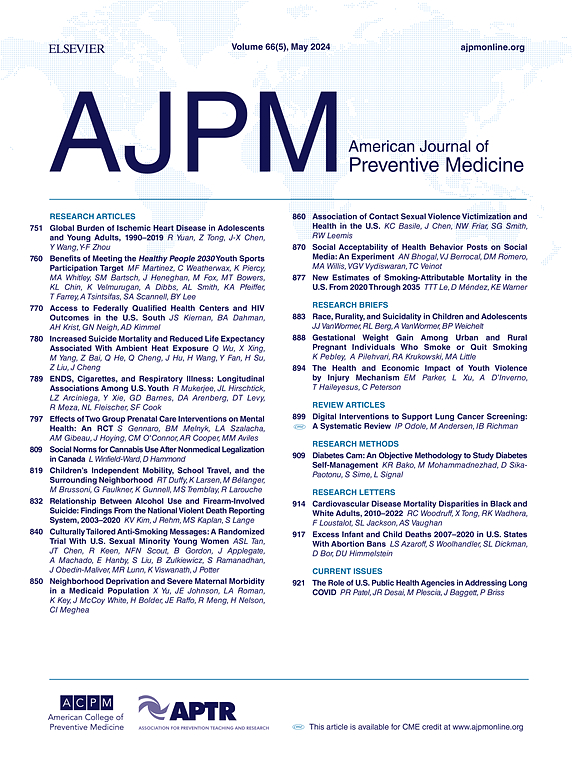Social Safety Net Programs: The Relationship With Drug Treatment Among Women
IF 4.3
2区 医学
Q1 MEDICINE, GENERAL & INTERNAL
引用次数: 0
Abstract
Introduction
Social safety net programs (e.g., Medicaid and government assistance) may facilitate drug use disorder treatment receipt. This study explored the associations of social safety net programs with drug treatment and medication for opioid use disorder receipt among women with drug use disorder and opioid use disorder, respectively.
Methods
Data were from the 2022 public-use National Survey on Drug Use and Health (analyzed in 2024) from women aged 18–64 years who met the criteria for past-year DSM-5 drug use disorder (n=2,784) and opioid use disorder (n=458). Odds of past-year drug use disorder treatment among women with drug use disorder and past-year medication for opioid use disorder treatment among women with opioid use disorder were estimated by government assistance and/or Medicaid receipt in primary analyses, followed by secondary categorizations of exposure (any government assistance, number of programs received), using separate logistic regressions, controlling for sociodemographics.
Results
In primary analyses, women with drug use disorder receiving both Medicaid and government assistance were more likely to report past-year drug use disorder treatment (AOR=2.91; 95% CI=1.60, 5.29) than women receiving neither. Women with past-year opioid use disorder receiving both Medicaid and government assistance were more likely to report medication for opioid use disorder (AOR=3.41; 95% CI=1.01, 11.61) than those receiving neither. Secondary analyses results were in the same direction.
Conclusions
Likelihood of drug treatment and medication for opioid use disorder receipt among women with drug use disorder and opioid use disorder, respectively, increased when Medicaid was combined with other forms of government assistance. Treatment costs and other barriers such as lack of insurance, childcare, and employment support are critical determinants of drug treatment; This study’s findings suggest that government support programs may help to buffer these known barriers.
社会安全网计划:与妇女药物治疗的关系。
社会安全网计划(例如,医疗补助和政府援助)可能促进药物使用障碍(DUD)治疗收据。本研究分别探讨了社会安全网计划与DUD和阿片类药物使用障碍(OUD)妇女的药物治疗和阿片类药物使用障碍(mod)接受的关系。方法:数据来自2022年全国公共用药与健康调查(2024年分析),来自18-64岁女性,符合过去一年DSM-5 DUD (n= 2784)和OUD (n=458)标准。在初级分析中,通过政府援助和/或医疗补助的接受情况来估计过去一年DUD女性患者接受DUD治疗的几率和过去一年OUD女性患者接受mod治疗的几率,然后进行二次暴露分类(任何政府援助;收到的项目数量),使用单独的逻辑回归,控制社会人口统计学。结果:在初步分析中,与未接受医疗补助和政府援助的女性相比,患有DUD的女性更有可能报告过去一年的DUD治疗(aOR: 2.91, 95% CI=1.60, 5.29)。与没有接受医疗补助和政府援助的女性相比,过去一年患有OUD的女性更有可能报告OUD (aOR: 3.41, 95% CI=1.01, 11.61)。二次分析结果与此一致。结论:当医疗补助与其他形式的政府援助相结合时,DUD/OUD妇女分别接受药物治疗和mod的可能性增加。治疗费用和其他障碍,如缺乏保险、儿童保育和就业支持,是药物治疗的关键决定因素;这项研究的结果表明,政府的支持计划可能有助于缓冲这些已知的障碍。
本文章由计算机程序翻译,如有差异,请以英文原文为准。
求助全文
约1分钟内获得全文
求助全文
来源期刊

American Journal of Preventive Medicine
医学-公共卫生、环境卫生与职业卫生
CiteScore
8.60
自引率
1.80%
发文量
395
审稿时长
32 days
期刊介绍:
The American Journal of Preventive Medicine is the official journal of the American College of Preventive Medicine and the Association for Prevention Teaching and Research. It publishes articles in the areas of prevention research, teaching, practice and policy. Original research is published on interventions aimed at the prevention of chronic and acute disease and the promotion of individual and community health.
Of particular emphasis are papers that address the primary and secondary prevention of important clinical, behavioral and public health issues such as injury and violence, infectious disease, women''s health, smoking, sedentary behaviors and physical activity, nutrition, diabetes, obesity, and substance use disorders. Papers also address educational initiatives aimed at improving the ability of health professionals to provide effective clinical prevention and public health services. Papers on health services research pertinent to prevention and public health are also published. The journal also publishes official policy statements from the two co-sponsoring organizations, review articles, media reviews, and editorials. Finally, the journal periodically publishes supplements and special theme issues devoted to areas of current interest to the prevention community.
 求助内容:
求助内容: 应助结果提醒方式:
应助结果提醒方式:


